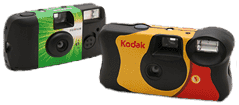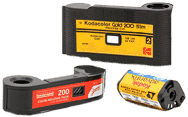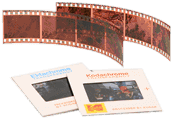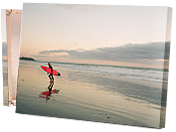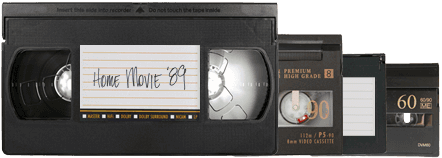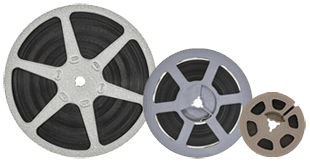So you love to travel and you love to shoot film? If so, you’ll often find yourself in an airport security line with a bag full of film. So what about those TSA X-rays and the new TSA CT Scanners? What effect can they have on your film?
This is a question we hear from our customers often. We have everything you need to know on the effects of the new CT Scanners, the traditional X-Ray scanners along with helpful tips to ease your mind on your next trip or when planning future film travels.

FAQs – Your Film and CT Scans/X-Rays
TSA CT Scanners
![]() While not at many airports yet, Kodak Alaris warns that the new TSA CT scanners WILL damage unprocessed film. Currently being rolled out in the US and other countries, just one scan from the CT Scanner could destroy your unprocessed film.
While not at many airports yet, Kodak Alaris warns that the new TSA CT scanners WILL damage unprocessed film. Currently being rolled out in the US and other countries, just one scan from the CT Scanner could destroy your unprocessed film.
When you make your way to the front of the line, just politely tell a TSA agent you have photographic film and you would like to request a hand-check.
Here are a few ways to keep your film organized and accessible for an efficient TSA experience:
- Take your film out of all canisters and wrappers.
- Place it in a transparent, ziplock bag.
- Keep your film in a side pocket or other easy-access area of your carry-on for quick removal.
- Don’t keep film in any luggage or baggage that will be checked. This includes cameras that still have film in them.
- Consider shipping your exposed film to the film lab for processing prior to your return trip… It’s easy if you take some prepaid mailers from The Darkroom.

This is what TSA’s new CT scanners look like.
TSA plans to have up to 145 units in place at airports around the nation by the start of 2020, along with 16 units at federal testing facilities.
TSA X-Ray Scanners
Most signs at TSA security checkpoints indicate film below 800 ISO will not be affected by the x-rays and, in our experience, this appears to be pretty accurate. We’ve sent dozens of rolls through x-rays (when the option to hand-check was not available) and the machines didn’t seem to have a very noticeable effect on the film—especially our black & white rolls.
Processed film is not affected by x-rays.

What is the most ideal way to safely get my film through security?
Don’t keep film in checked baggage!
Checked baggage often goes through equipment with higher energy X rays, but X-ray equipment used to inspect carry-on baggage uses a very low level of x-radiation that will not cause noticeable damage to most films. The high-dose X-ray scan on checked baggage can damage film immediately and corrections can’t be made at the processing lab.
See below for examples of how X-rays affect film in checked baggage.
We always recommend getting your film hand-checked if possible, especially if you’re travel will include multiple x-ray scans. Even if it is below 800 ISO. We prefer to err on the safe side when your sweet analog memories could be at risk. When you make your way to the front of the line, just politely tell a TSA agent you have photographic film and you would like to request a hand-check.
Here are a few ways to keep your film organized and accessible for an efficient TSA experience:
• Take your film out of all canisters and wrappers.
• Place it in a transparent, ziplock bag.
• Keep your film in a side pocket or other easy-access area of your carry-on for quick removal.
• Don’t keep film in any luggage or baggage that will be checked. This includes cameras that still have film in them.
• Consider shipping your exposed film to the film lab for processing… preferably to The Darkroom.
Instant Film
Always have instant film hand checked and never have it scanned through the x-ray machine. It must be hand checked. Film that’s wrapped in silver wrapping will likely be opened by the TSA agents, so you’ll save time and have it done with more care if you prepare it yourself prior. Anything instant such as Polaroid, Fuji pack film and Instax will be fogged with muddy shadows when scanned by the x-ray machines.
What if I can’t get my film hand-checked?
If for some reason you don’t have time, aren’t permitted, or totally forget to request a hand-check for your film, don’t sweat it. The odds are in your favor. We’ve gathered a handful of our x-rayed film scans—most of which went through an x-ray a total of 6 times and still produced great results!
Kodak TMAX400 U.S. X-RAY 4 TIMES
Ilford SFX 200 EU X-Ray 6 times
Ilford DELTA 3200 EU X-RAY 6 times
Examples of how X-ray effects film in checked baggage.
Below illustrates the extreme effects of X-rays when scanned in checked luggage.
If you’re curious, here’s what to expect when your film is scanned in check baggage.
Source: Kodak.com
Exposure from checked baggage scanners can have an extreme effect and fog film. Fog typically appears as soft-edged bands 1/4 to 3/8 inch (1 to 1.5 cm) wide. The orientation of the fog stripe depends on the orientation of the film in the scanner relative to the X-ray beam. The X-ray banding is often linear or wavy running lengthwise or horizontally on the film. Whether the undulating wavelengths is visible depends on the photographic content. Busy scenes will obscure or lessen X-ray effects, otherwise, the photo may display some signs of wavy lines or fogging.
black-and-white negative films – Patterns in dark areas
color-negative films – Neutral or brown patterns in the dark area
slide film – Neutral or brown Patterns in the light areas
 800 speed film scanned with Examiner 3DX 6000 X-Ray check baggage scanner
800 speed film scanned with Examiner 3DX 6000 X-Ray check baggage scanner
 As an example of how X-ray effect film, below is an unexposed KODAK VISION 200T negative film scanned by a checked-luggage scanner.
As an example of how X-ray effect film, below is an unexposed KODAK VISION 200T negative film scanned by a checked-luggage scanner.



 My Account
My Account

